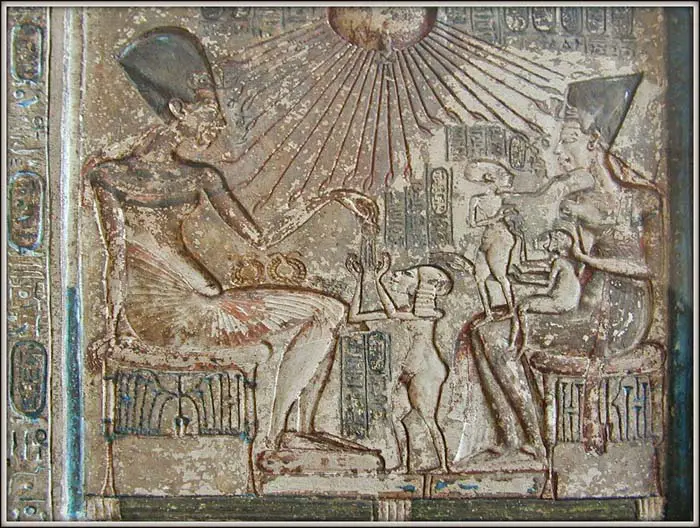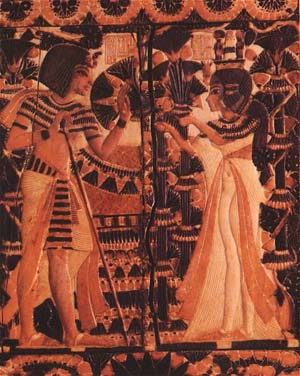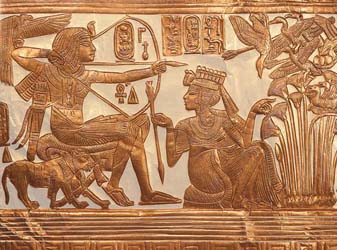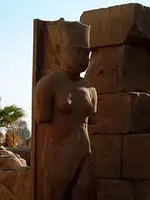Ankhesenamun
Queen Ankhesenamun was the chief wife of King Tutankhamun. Because of the mystery that surrounds much of her life, she is known as ‘Egypt’s Lost Princess’. She was born during Egypt’s most unsettled times in the 18th dynasty and her life reflected the turbulence of her country.
Born Ankhesenpaaten, she was named after her father, the heretic pharaoh, King Akhenaten. The “aten” at the end of her name meant that “she lives through Aten.” This honored the one god King Akhenaton believed to be the only true god. After King Akhenaton’s 17 year reign, he was forced to give up his position and Ankhesenpaaten’s name was changed to Ankhensenamun to reflect the will of the Priests of Amun.
The Egyptian Queen’s Family Tree
As the third of six daughters of King Akhenaton and Nefertiti, she and her two older sisters were known as the “Senior Princesses” and were depicted much more often than their younger siblings in reliefs. Her two older sisters were named Meritaten and Meketaten.

© Jean-Pierre Dalbéra - Akhenaton and Nefertiti with their daughters
Her father, King Akhenaton, also fathered her husband, King Tutankhamun and there is speculation as to whether King Tut’s mother is Nefertiti, or a lesser wife known as Kiya. Part of the reason for the obscurity is that after King Akhenaton’s reign, the succeeding Pharaohs, including his son, King Tut, tried hard to erase King Akhenaton’s name from history. In the process, they destroyed much of the family lineage evidence.
A Young, Happy Marriage to a Famous Pharaoh

© Tiger Cub - King Tut receiving flowers
from Ankhesenamun as a sign of love
Queen Ankhesenamun married King Tut at the tender age of 13. King Tut was even younger at just a few years shy of ten. The couple was married in 1334 BC. They lived in Amarna, the city King Akhenaton built for four years until they moved back to the capital city of Thebes. Thebes was the center of worship for the god Amun, and it was at this time that the couple changed their names to reflect acceptance of him.
Despite the couple’s happy marriage, it was marred by the fact that none of their children survived infancy. Queen Ankhesenamun and King Tut’s babies’ mummified remains were found in King Tut’s tomb. Both of them were girls. One was no more than five months gestation and the other no more than 7-9 months gestation. DNA testing has determined that the older one had Spengel’s deformity along with spina bifida and scoliosis. It is likely that these conditions were caused by the close blood lines interbreeding, as was the practice at the time to maintain royal lineage.
Queen Ankhesenamun – A Sorrowful Egyptian Queen
At just 18 years old, King Tutankhamen died. Queen Ankhesenamun was left a widow at 21. At this time, the young Queen’s grandfather and King Tut’s advisor, Ay, proclaimed that they would marry. Ay wanted to secure his claim to the throne. Queen Ankhesenamun strongly opposed this union. She wrote to Suppiluliuma I, King of the Hittite Empire and asked if she could marry one of his many sons. The King agreed and sent his son, Prince Zannanza to Egypt. Unfortunately, the prince and his travel group were murdered at the border to Egypt. Queen Ankhesenamun was forced to marry King Ay.

© Asaf Braverman - King Tut and Ankhesenamun
There is evidence that suggests Queen Ankhesenamun married four pharaohs in her short life. At one point King Akhenaton tried to father children with all of his three eldest daughters. One of these daughters died during childbirth. For a short time, Queen Ankhesenamun was married to her father, King Akhenaton. She was also married to Smenkhkare (King Akhenaton’s co-regent) for one to three years. The Egyptian Queen’s marriage to King Tut lasted for about ten years and then she was married to her grandfather, King Ay for a short time. It was during her marriage to King Ay that she died mysteriously. Her death happened somewhere between 1325 BC and 1321 BC.
A Missing Tomb
Despite being King Tutankhamen’s chief spouse and consort, Queen Ankhesenamun’s burial place remains unknown. There are also no funerary objects that exist with her name on them. There are statues of the queen, usually depicted with King Tutankhamen. Horemheb, the last pharaoh of the 18th dynasty, built statues of the king and queen in a temple he built. Queen Ankhesenamun is standing behind King Tutankhamen. The queen is also depicted on several monuments near Memphis.
Queen Ankhesenamun Quick Facts
- Third daughter of the heretic Pharaoh, King Akhenaton and Nefertiti
- Chief wife and consort to famous “boy king” Tutankhamun
- Failed to produce an heir with King Tut, two stillborn daughters found mummified in King Tut’s tomb
- Possibly married to four different pharaohs during her lifetime
- Mystery surrounds her death, some believe King Ay might have murdered her
- Name change reflects the turbulence of the times. Born Ankhesenpaaten which meant “She lives through Aten” – later changed to Ankhesenamun which meant “She lives through Amun”
- Wrote letter to Hittite King, Suppiluliuma I, to ask for one of his son’s hand in marriage in a failed attempt to avoid marrying her grandfather, Ay

